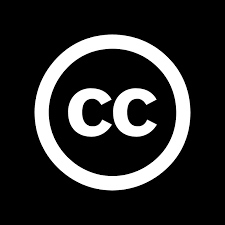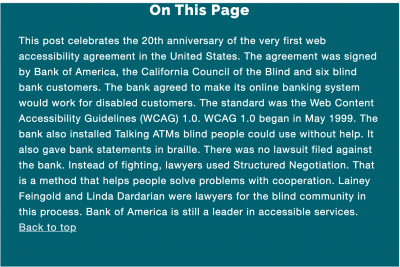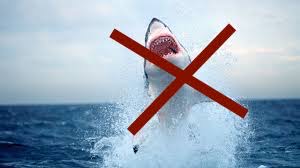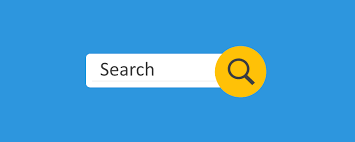
Thanks to web developer extraordinaire Natalie Maclees of Digita11y, my site has a new design. For one thing, there are now dolphins leaping out of the water at the top of every page. Here’s more about that and the other changes.
share on linkedinshare on bluesky
No more copyright
 I have removed the copyright symbol — (c) — at the bottom of every page on the site. Now there is a notice in the footer that LFLegal.com is licensed under Creative Commons. (The circled double c that is the Creative Commons logo appears in the image for this section.)
I have removed the copyright symbol — (c) — at the bottom of every page on the site. Now there is a notice in the footer that LFLegal.com is licensed under Creative Commons. (The circled double c that is the Creative Commons logo appears in the image for this section.)
The tagline for Creative Commons is that they are “building a vibrant, collaborative global commons” and “a more equitable, accessible, and innovative world.”
I decided to contribute to that global commons by making the content of this website free to all who accept the terms of the creative commons license.
Specifically, I have chosen the “Attribution-NonCommercial-ShareAlike 4.0 International” Creative Commons license.
This license means that anyone is free to share or adapt content they find on this website as long as you
- give appropriate credit
- provide a link to the license
- indicate if changes were made
- not use the material for commercial purposes
- ShareAlike, which means that if you remix, transform, or build upon this website’s content, you must distribute your contributions under the same license as I’m using
- do nothing legally or technologically that would limit other people’s use of this site as provided for in the Creative Commons license
My goals in maintaining this website include spreading the word about the value of collaboration and the critical importance of digital accessibility and inclusion of disabled people in all aspects of the digital world.
The Creative Commons license suits that purpose, and I feel good about contributing to the collaborative global commons.
I never did charge people who wanted to re-publish content on this site (though I certainly appreciated those who asked). So if you see anything you’d like to share with your communities consistent with the creative commons license, I hope you will. You will be contributing to an open source, free global commons.
How great is that?
Back to topSummaries at the top of every article
 Since I launched this website in 2008, I have written short summaries that appear at the end of each article. Each summary is designed for a 9th grade reading level or below, as measured by the Flesch-Kincaid Grade Level tool built into Word (find it in the spell check function.)
Since I launched this website in 2008, I have written short summaries that appear at the end of each article. Each summary is designed for a 9th grade reading level or below, as measured by the Flesch-Kincaid Grade Level tool built into Word (find it in the spell check function.)
I do these summaries to meet Web Content Accessibility Guideline (WCAG) Success Criteria (SC) 3.1.5, a WCAG 2.1 AAA Reading Level requirement. (My website was designed to meet WCAG 2.0 AAA standards in 2008, and WCAG 2.1 AAA standards in 2018, the year those guidelines became effective.)
Often I’ve been frustrated by this success criteria and the effort it takes to meet it. I’ve asked myself — Does anyone read these summaries? Are they helpful to anyone? In the last couple of years I’ve realized that the answer is Yes! But not only for the reasons I thought.
According to guidance for SC 3.1.5, “This Success Criterion helps people with reading disabilities while also allowing authors to publish difficult or complex Web content.” But the simplified summaries do more. They offer a snapshot of the full article to everyone who wants a little taste before spending time on the whole dish.
In other words, the summaries are an example of a truism: Accessibility is essential for some, useful for all. (That’s a phrase I learned from the Web Accessibility Initiative that offers a great series of short accessibility videos on this theme.)
It was Jamie Knight who first suggested that the summaries be placed at the top of each article. Now they will be.
Back to topDolphins swimming in the header
 Lawyer as shark is an age-old metaphor. I reject it. For twenty-five years my clients, co-counsel and I have developed a collaborative way to practice law called Structured Negotiation. This method requires communication, listening, patience and more.
Lawyer as shark is an age-old metaphor. I reject it. For twenty-five years my clients, co-counsel and I have developed a collaborative way to practice law called Structured Negotiation. This method requires communication, listening, patience and more.
I have adopted the dolphin to better represent the kind of advocate I strive to be. And I have adopted the dolphin as a metaphor for the collaboration that has been effective for advancing digital accessibility. My refresh gives dolphins pride of place in the header because collaboration is a core value of my work.
- Read more about why I chose the dolphin to represent the values and strategies of Structured Negotiation.
- Read my 2018 article published by the American Bar Association, Forget The Shark And Be A Dolphin Instead: Structured Negotiation Skills For Practitioners
Better Info about my Talks and Trainings
I’ve updated my speaking page. What a joy it has been for the past four years to speak to audiences about digital accessibility and Structured Negotiation. My post-book travels have taken me to Canada, Australia, New Zealand, Spain and across the United States.
And while the global pandemic has of course ruled out in-person events, I am confident that those gatherings will one day return. In the meantime, I’m grateful that technology allows opportunities to connect with audiences next door and around the world. The updated speaking page will make it easier for organizers to understand what I can offer their audiences. And easier to find what people say about my talks.
Public speaking is one of my most favorite activities. Refreshing the speaker page in 2020 feels like a leap of faith during these very difficult times. But optimism and confidence are two dolphin traits I write about in my book and that have served me well for many years. I decided not to abandon them now.
Back to topAn easier to find search box
 This website has a lot of content! I needed a more visible way for site visitors to find it on a mobile device.
This website has a lot of content! I needed a more visible way for site visitors to find it on a mobile device.
The search box used to be part of the mobile menu. Now the search field is on its own at the top of every screen.
As of today, there are 352 articles and 27 pages on this website. Here are some other ways to search content:
- Visit the Topics Page. You’ll find 39 topics into which all the content on this site is organized. Select a topic and you’ll be taken to a page with links to all the articles about that topic. In the past few months I’ve added two new topics. One is for articles about ethics in the digital accessibility space titled Ethics. The second celebrates Structured Negotiation achievements I was not involved in.
- Visit the Articles Page to find a short summary with a link to every article on this site in reverse chronological order (most recent articles first).
- Visit the Archives page for two lists (with links) of every article on this site. One list has every article by month and year. The other list has every article by title in alphabetical order.
- Visit the Writings Page for Lainey’s articles first published somewhere besides this website.
And don’t forget the new search box!
I Love Feedback
Please let me know what you think of the refreshed site. I value all feedback and try my hardest to respond to every email I receive. Visit the Contact Page now.